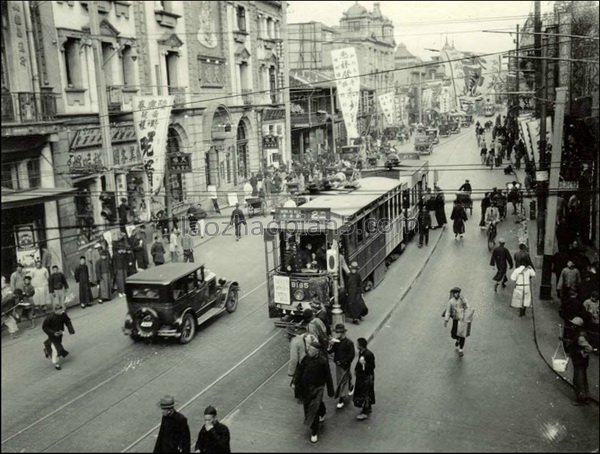Period:Ming dynasty Production date:1626 (dated)
Materials:earthenware
Technique:glazed, biscuit-fired, moulded,
Subjects:deity
Dimensions:Height: 80 centimetres Width: 26 centimetres Depth: 16 centimetres
Description:
Standing military figure, biscuit-fired with ink-blue and turquoise glazes. This celestial military figure stands on a rectangular plinth with his feet apart, his hands together in front of his chest in prayer, his eyes inclined towards the ground and head slightly bowed in an attitude of servitude and respect. He is lavishly dressed in Y-shaped chain-mail armour over a long-sleeved round-necked robe fastened by a broad belt inset with ornamental plaques with the head of a fierce animal inverted above. He also wears long boots and has gartered legs. Animal mask epaulettes form a frame behind his head and his helmet, which is topped with a pommel, is tied on by a bow beneath the chin and has attached mantling covering the hair. The areas of exposed flesh and the armour are biscuit-fired, suggesting the texture of skin and leather with traces of gilding remaining on some parts of the armour. A fugitive ink-blue and turquoise glaze is applied to the other areas. The plinth and support which steadies the figure between its legs are unglazed. The back of the skirt of the figure’s robe is marked with an incised inscription giving its date of manufacture.
IMG
![图片[1]-figure BM-OA+.530-China Archive](https://chinaarchive.net/Ming dynasty/43/mid_RRC3030.jpg)
![图片[2]-figure BM-OA+.530-China Archive](https://chinaarchive.net/Ming dynasty/43/mid_00090969_001.jpg)
Comments:Harrison-Hall 2001:This figure may be identified as Wei Tuo, Heavenly King or Guardian God of a Buddhist temple. Two earlier similar Heavenly Kings, carved from stone and with a rectangular back plate, were discovered in Sanming city, Fujian province, in 1984, part of a batch of Ming stone sculptures measuring 110-114 cm in height, sculpted in a similar pose, wearing similar costume and dating to the Zhengde period (1506-22). Also connected to the British Museum’s figure is a large yellow-and-green tile in the Victoria and Albert Museum, London, with a dedicatory inscription to the long life and happiness of the people of Mashan, western Hebei, dated 1548. Although this figure is large, it may have been made as part of a centre piece for a temple roof finial. An example of such a centre piece is on the hall to Manjusri, Foguang monastery, Mount Wutai, Shanxi province. It includes a tile of a guardian figure wearing military costume, standing on a rock, and higher up it includes further tiles with three-dimensional figures.
Materials:earthenware
Technique:glazed, biscuit-fired, moulded,
Subjects:deity
Dimensions:Height: 80 centimetres Width: 26 centimetres Depth: 16 centimetres
Description:
Standing military figure, biscuit-fired with ink-blue and turquoise glazes. This celestial military figure stands on a rectangular plinth with his feet apart, his hands together in front of his chest in prayer, his eyes inclined towards the ground and head slightly bowed in an attitude of servitude and respect. He is lavishly dressed in Y-shaped chain-mail armour over a long-sleeved round-necked robe fastened by a broad belt inset with ornamental plaques with the head of a fierce animal inverted above. He also wears long boots and has gartered legs. Animal mask epaulettes form a frame behind his head and his helmet, which is topped with a pommel, is tied on by a bow beneath the chin and has attached mantling covering the hair. The areas of exposed flesh and the armour are biscuit-fired, suggesting the texture of skin and leather with traces of gilding remaining on some parts of the armour. A fugitive ink-blue and turquoise glaze is applied to the other areas. The plinth and support which steadies the figure between its legs are unglazed. The back of the skirt of the figure’s robe is marked with an incised inscription giving its date of manufacture.
IMG
![图片[1]-figure BM-OA+.530-China Archive](https://chinaarchive.net/Ming dynasty/43/mid_RRC3030.jpg)
![图片[2]-figure BM-OA+.530-China Archive](https://chinaarchive.net/Ming dynasty/43/mid_00090969_001.jpg)
Comments:Harrison-Hall 2001:This figure may be identified as Wei Tuo, Heavenly King or Guardian God of a Buddhist temple. Two earlier similar Heavenly Kings, carved from stone and with a rectangular back plate, were discovered in Sanming city, Fujian province, in 1984, part of a batch of Ming stone sculptures measuring 110-114 cm in height, sculpted in a similar pose, wearing similar costume and dating to the Zhengde period (1506-22). Also connected to the British Museum’s figure is a large yellow-and-green tile in the Victoria and Albert Museum, London, with a dedicatory inscription to the long life and happiness of the people of Mashan, western Hebei, dated 1548. Although this figure is large, it may have been made as part of a centre piece for a temple roof finial. An example of such a centre piece is on the hall to Manjusri, Foguang monastery, Mount Wutai, Shanxi province. It includes a tile of a guardian figure wearing military costume, standing on a rock, and higher up it includes further tiles with three-dimensional figures.
© Copyright
The copyright of the article belongs to the author, please keep the original link for reprinting.
THE END




![[Qing Dynasty] British female painter—Elizabeth Keith, using woodblock prints to record China from the late Qing Dynasty to the early Republic of China—1915-China Archive](https://chinaarchive.net/wp-content/uploads/2022/11/image-191x300.png)
